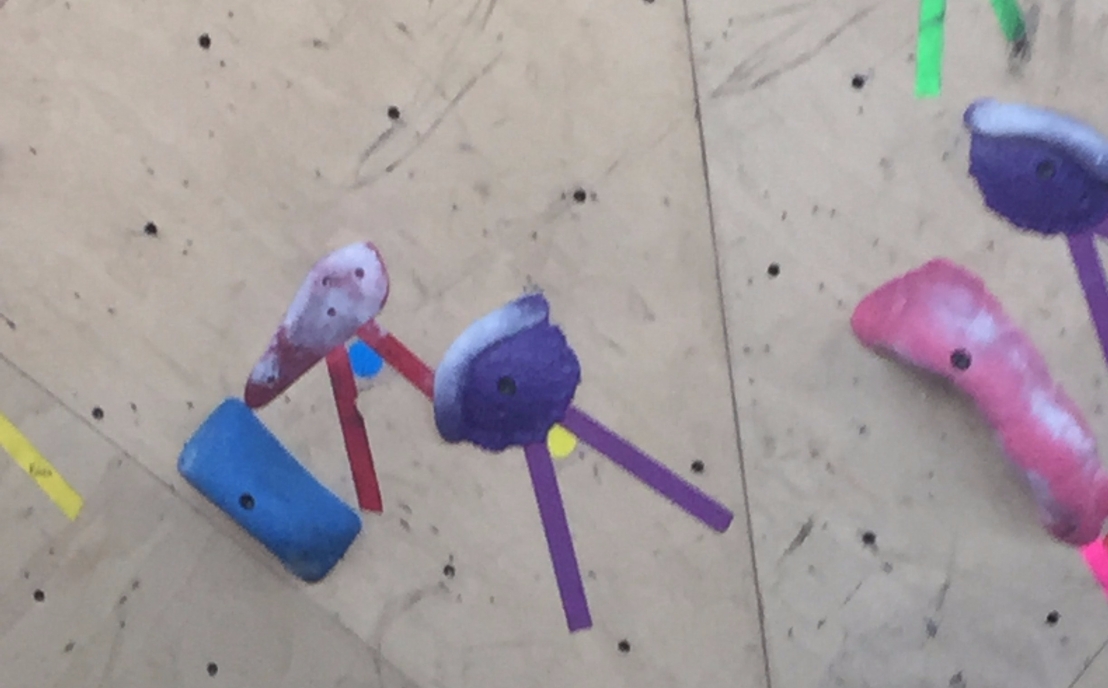For those of you following along, this is my update on learning to rock climb. For those of you who have no idea what I’m talking about, read the initial post here or the final part here.

Since the last post, I have done some more research, signed up at my local rock climbing gym, and started climbing. REI has been the most helpful with research, they provide in depth information from basics to specific equipment needs. REI is a world leader in outdoor recreation, their articles are up to date and written by professionals. After reading several REI articles I was ready to apply my research to the real things.
So, I went to my local rock climbing gym and signed myself for a membership. The gym is called The Front, and the guy who signed me up was very welcoming. Now that I was a member, the next step was to actually climb. Taking this journey one step at a time, I decided to wait a day before I jumped right in. That night I realized, I didn’t know which color holds corresponded to which difficulties. I looked it up and found that gyms will post the colors and their difficulties.

The next day I showed up at The Front, rented a pair of shoes, and made my way to the bouldering wall. I spent a chunk of time walking around, trying to figure out the difficulties and a place to practice. Finally, I found a guide which color coordinated the difficulties. I was then able to pick a spot and attempt one of the routes. I tried to stick pretty strictly to the novice routes (yellow). After about fifteen minutes of trying various yellow paths, and not having much success I looked around at the other climbers.
Some were much more skilled than I was, but I noticed they were on routes, according to the guide, marked as beginner or intermediate. Not only that, but I noticed some of the advanced routes looked pretty easy. I started to question the guide, and what I knew. As Berger (2014) suggests, I had to step away from doing, and knowing to ask why. Why were these expert climbers on novice routes? Why is this route advanced? Soon I found my answers, I had misread the difficulty guide, it was not the color of the holds, it was the dots under the holds that showed the difficulty. After having this “aha” moment I started to have some success.

Rock climbing is a metacognitive sport. Several times after failing I stared at the wall, trying to figure out how to get to the next hold, and what went wrong. Like a true maker, I used a test and learn approach. I had to attempt multiple times, and transfer my knowledge to different situations to achieve my goal of making it to the top (Bronson 2000).

My largest obstacle to overcome is my inexperience. In my head, rock climbing is a very vertical sport but, I saw horizontal and inverted movements. There are so many different ways to get up the wall. This reimagining is what Berger (2014) refers to as “vuja de.” Looking at something you have seen before from a different perspective. Right now I can only see one way up the wall, straight. As I practice I will be able to see the wall from new perspectives enhancing my climbing. As I improve I will also face different holds which require new techniques and new perspectives. With practice I will be able to recognize patterns, see new perspectives, and gain the strength needed to climb. I have found these videos, from Howcast and Bouldering Bobat, on different types of holds to be helpful in how to improve my climbing.
Overall, I am pleased with my rock climbing progress. It was very nerve wracking, at first. I felt all eyes were on me, but the more I attempted the more fun I had. I’ve taken a couple large steps, now I need to work on my form and climbing more difficult routes.
________________________________________________________________________________
References
Berger, Warren. (2014). A More Beautiful Question: The Power of Inquiry to Spark Breakthrough Ideas. New York: Bloomsbury.
Bransford, J., Brown, A.L. & Cocking, R. R. (2000), How people learn: Brain, mind, experience and school. Washington, D.C.: National Academy Press.
All pictures and video in this post were taken by Alex Gorton


Alex, I totally see how that could be deceiving! Despite the fact that the sign says, “Look for the colored dots,” I’m sure I would also assume that the color pertained to the hold. I wonder how many others have made that same mistake! Also, maybe we should give our students a little more grace when it comes to reading directions thoroughly. 🙂 Glad you figured it out eventually!
LikeLike
Ok, I love this! Mostly it reminds me of a mistake I would make. I often find it difficult to ask for help when I am struggling with a task, whatever it may be. That has caused me to become an excellent people watcher when trying to solve problems, like the one you encountered here! Sometimes it is good to ask for help, but sometimes you don’t have to do that. Sometimes all you need to do IS ask those Why? What if? How? questions, like you discussed here. Being an observational person and a good problem solver sometimes goes hand in hand, eh? Good job!! You’re braver than me.
LikeLike